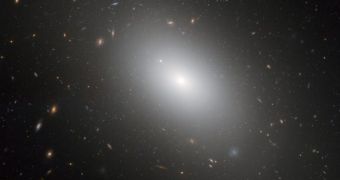Located more than 320 million light years away, in the Eridanus constellation, the galaxy NGC 1132 represents a class of giant elliptical galaxies, surrounded by a group of dwarf galaxies named by astronomers, the 'fossil group.' The shear size of the elliptical galaxy in relation to its much smaller companions suggests that it could have formed through the collision of a large number of galaxies in the recent past.
It sits isolated in the middle of a population of dwarf galaxies, and seems to be residing inside a massive cloud of dark matter, which can only be found in galactic neighborhoods counting hundreds or tens of individual galaxies. Furthermore, NGC 1132 presents a strong X-ray emission generated by large amounts of hot gas, extending into intergalactic space ten times more than the visible light glow, which measures a radius of 120,000 light years. Astronomers estimate that the X-ray emission of the single elliptical galaxy is comparable to that of a whole group of galaxies.
The presence of the small dwarf galaxies in the vicinity of the massive elliptical galaxy cannot be yet explained, but the most likely scenario is that they are remnants of a galactic collision between a large number of galaxies. Alternatively, astronomers propose that they did not evolve into larger galaxies due to the fact that their growth had been prevented through some unknown process, once one large galaxy has formed.
Usually, galaxies are part of groups that hold on to each other through powerful gravitational interactions. Sometimes they draw together too close and collide with each other, process that would eventually end in a merger that creates a single galaxy. Observation in the Local Group shows that our own Milky Way might have collided many times during its life with other smaller galaxies, which contributed to the rise in the population of stars.
It is widely believed that elliptic galaxies are mostly the remnant of the galaxy that collided and merged with multiple galaxies during their history. Unlike spiral galaxies, elliptical galaxies have no features and may contain as much as a hundred of trillions of stars. From time to time, some might take an elongated shape. Most of the stars contained by elliptical galaxies emit a yellowish color, a sign that they are extremely old, and the galaxy doesn't contain enough gas to determine another star formation process.

 14 DAY TRIAL //
14 DAY TRIAL //